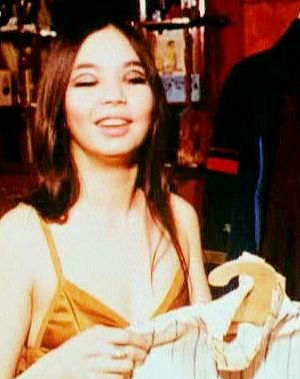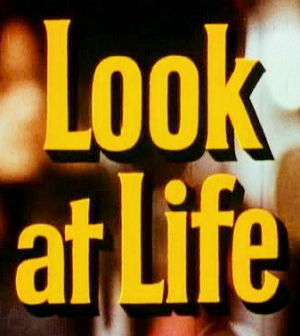2008-08-16
IN Gear

Tailor John Pearse, graphic artist Nigel Waymouth (and girlfriend Shelagh York) opened Granny Takes A Trip in 1965. At the entrance was some lettering reading ‘one should either be a work of art or wear a work of art’. Granny Takes A Trip was the first multisex boutique selling miniskirts, op art shirts, garments in loud florals and paisleys… Perhaps more of importance were the second hand ornaments: flapper dresses, Victorian bustles, Boer War helmets, antique military jacquets, Chicago gangster suits, fezzes, turbans and other ‘cleaned and darned exotica’.
Nigel Waymouth: "I was with this girl at the time and she used to collect old clothes. We thought that it might be a good idea to open a shop with all these things. (…) Of course it was terribly vain."
The Granny T-a-T boutique was known for its outrageous decoration. The entrance of the shop changed a few times: in the early days it had a mural of a North American Indian, in 1966 (probably) it was replaced by a pop art picture of Jean Harlow and at a later stage a real Dodge (well, part of it) was pop-artistically glued to the wall.
Granny was expensive, elitist and wasn’t afraid of saying so. Journalist and critic Jonathan Meades once tried to get in dressed in a casual black suit and tie: “I remember Nigel Waymouth sneering at me, you could hardly see his face by through this mass of afro hair. (…) He obviously thought I was a jerk. (…) and wanted me moved out of the way because I was an extremely bad advertisement for his shop.”
"The underground was exactly the same as everything else: there were rich people and there were poor people. It was class ridden. There was no working class in the underground because nobody did any work." (Cheryll Park, art-student).
"The underground had a star system exactly as did pop music and films and everything else." (Andrew Bailey, journalist Variety, Rolling Stone UK).
The press that cherished Swinging London reported vividly about the so-called mundane settings (shops, bars and restaurants) visited by working class heroes such as Michael Caine and Twiggy. The sudden press attention made the flower power movement mushroom and disappear in a couple of months time.

Look At Life was a series of short documentaries about British life, made by Rank Organisation and shown in the Odeon and Gaumont movie theatres. Between 1959 and 1969 over 500 tongue-in-cheek episodes were made. One particular episode from 1967, called IN Gear, narrated by Michael Ingrams, deals with several Swinging London shops and clubs.
It's the swinging London fashion scene on parade and features an eye-candy array of dazzling & colourful mod fashions! Suits, shirts, pants, shoes, boots, jackets, dresses, belts, bags, hats, caps, ties, skirts, blouses, scarves, dickies, and more! Mary Quant shows off her latest collection! The viewer is taken to King's Road, SOHO, and Carnaby Street.
Some of the shops visited are: "Granny Takes a Trip," "Hung on You," "The Antiques Supermarket," "I Was Lord Kitchener's Valet," and "Gear."
The narrator tells us that, "A year or two ago fashion originated in the haute couture's of Paris, then spread downward through society in ever cheapening copies; now these shops which would have interpreted the mould, originate today's fashion, owing nothing to Paris or anyone else."
Next, it's off to the discotheque club scene where the "in" gear is worn. Clubs include: "Tiles," "Bag of Nails" (the Beatles used to hang out here), "Samantha's," "Georges" and "the Saddle Room." Groovy pop music soundtrack! (Taken from Videobeat.)

When Late Night member dollyrocker watched this particular episode on YouTube she recognised a familiar face at 1:43. The girl who visits the Granny Takes A Trip shop is none other than Iggy the Eskimo. This probably means that she was hired by the makers of the documentary as an actor for the movie and further proof indeed that she was a professional model.
Unfortunately the credits have been cut of from the YouTube video and I’m not sure if they appear on the Swinging London DVD it was taken from (unfortunately the DVD is out of print and its editor DD Home Entertainment is out of business).
We don’t know exactly when the documentary was made but as another shop, Biba, moved somewhere between March and September 1966 to Kensington Church Street, and that location is shown in the movie, one can deduct that the movie dates from summer 1966 - spring 1967.
So far for the small story. But what really matters is:
Who hired Iggy for the documentary?
What agency did she belong to?
If
she was a professional model there must still be promo shots or fashion
photo shoots available in the darker corners of this world…
A gallery with screenshots of the movie can be visited here.
Sources (other than the above internet links)
Green, Jonathon: All
Dressed Up, Pimlico, London, 1999, p. 80-81.
Green, Jonathon: Days
In The Life, Pimlico, London, 1998, p.187-190., p. 218-220
Levy,
Shawn: Ready Steady Go!, Broadway Books, New York, 2003,
p.190-191.

